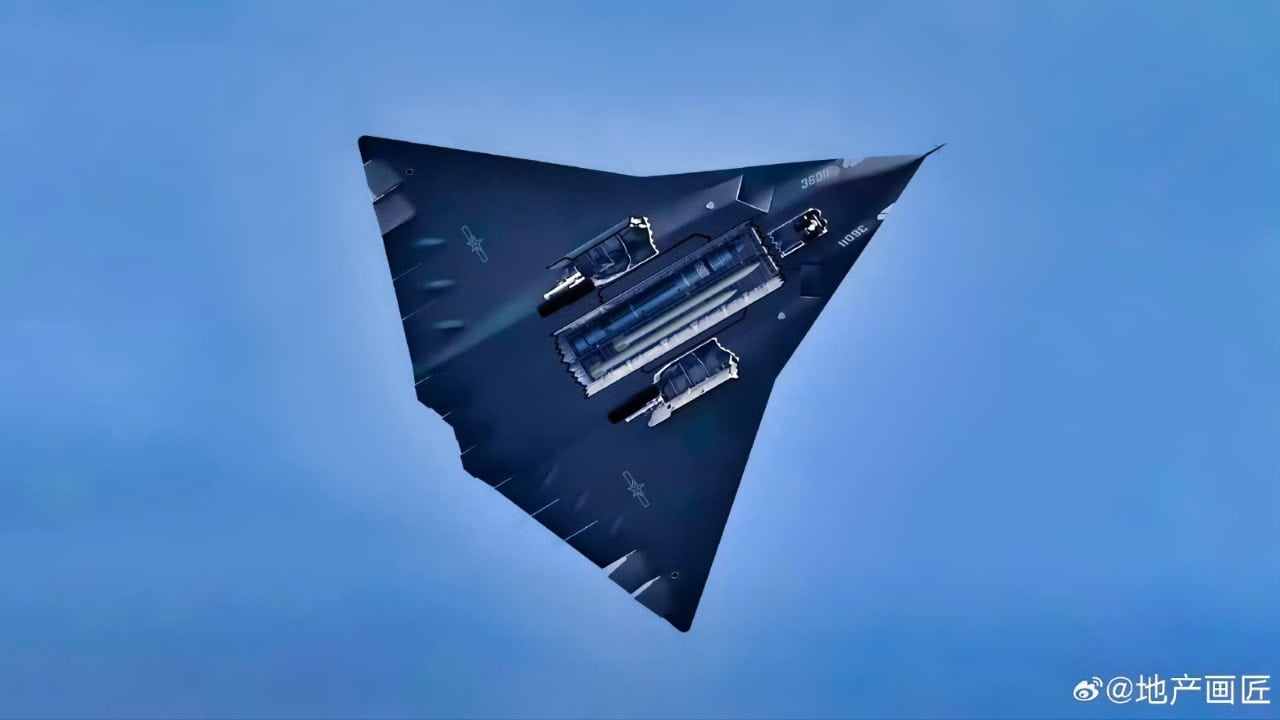Summary and Key Points: China’s new tail-less fighter, likely called the J-36, recently completed its second test flight, fueling speculation it’s a sixth-generation stealth aircraft.
-Developed by Chengdu Aircraft Corporation, this fighter has advanced stealth characteristics, a triple-engine setup for powerful thrust and maneuverability, and is possibly capable of launching hypersonic missiles and drones.
-Its design emphasizes radar stealth, potentially includes near-space laser capabilities, and likely strengthens China’s nuclear deterrent.
-The J-36 underscores China’s progress in aerospace and suggests an advantage as the U.S. Air Force pauses development of its Next-Generation Air Dominance fighter, making it a significant milestone in China’s military advancement.
China’s J-36 Fighter Just Conducted Another Test Flight
In a notable development for the Chinese military aerospace industry, a large, tail-less fighter jet has flown for the second time. This is believed to be a new stealth warplane – likely the People’s Liberation Army Air Force (PLAAF)’s version of a 6th generation fighter. This jet flew for the first time on December 26.
The airplane glimpsed on social media on March 17 would have a sizable advantage in aerial warfare. It has been labeled the J-36 and is being produced by the Chengdu Aircraft Corporation. The private satellite imagery company Planet Labs produced a shot of what appears to be the J-36’s hangar. This is a large building meant to accommodate the stealth jet’s immense wingspan. There are also other facilities there to hold smaller fighters such as the J-10 and J-20, that Chengdu is building.
The canopy on the J-36 is big and this could mean there is a side-by-side pilot and co-pilot configuration. The airplane has a wide nose, too.
The War Zone describes more about the design. “We also get more evidence that the dorsal intake uses a diverterless supersonic inlet (DSI) design, with the prominent hump and forward-raked upper area seen in this profile shot.”
What is also a significant feature of the J-36 is that it looks like it has three engines. This would be evidence that it is powerful and fast with super maneuverability. This kind of performance is what one would expect from a 6th generation airplane.
The tail-less design will reduce the J-36’s radar signature to add more stealth features. The aerodynamic nature of the airplane and the three engines will likely make it able to accelerate with more power for increased thrust and supercruise ability. The engine exhausts are mounted on top of the rear fuselage for better radar evasion – similar to the American YF-23 Black Widow II. The J-36 likely has improved significantly in its stealth characteristics compared to the J-20.
“Also notable is the elaborate arrangement of control surfaces coupled with the tailless design, with five trailing edge control surfaces per wing. These include prominent split flaps close to the wingtips. These would be used differentially to provide yaw control in the absence of tail control surfaces, as well as deploying simultaneously to serve as air brakes,” the War Zone wrote.
The J-36 Can Carry a Lot of Weapons
The J-36 will likely carry a vast weapons load. It is likely meant to launch hypersonic weapons. While it is unclear if it could be a drone mothership with a “Loyal Wingman” uncrewed fighter flying in tandem, it is probably a feature that the Chinese would likely emulate. The U.S. Air Force’s Next-Generation Air Dominance (NGAD) fighter could control a Collaborative Combat Aircraft drone someday for better situational awareness and the ability to collect reconnaissance data and to conduct targeting duties.
Plus, the J-36’s size means that the fuel capacity is high. This means that aerial re-fueling could help it travel to many hot spots in East Asia. It is unclear if there will be a naval version of the J-36, but I’m sure the Chinese would love to have a 6th generation airplane that could conduct aircraft carrier operations.
The J-36 is probably going to be nuclear-capable too. This would boost the Chinese nuclear triad, which is advancing nicely for Beijing. Pairing the J-36 with China’s flying wing stealth bomber called the H-20 would be advantageous for nuclear deterrence. China has around 600 warheads and wants to have 1,000 nuclear weapons in its stockpile by 2030.
There is also a good chance that the J-36 will have lasers on board to fly near space altitudes and take out satellites.
China is likely thrilled with the progression of the J-36. The American NGAD is on operational pause as the Department of Defense ponders its future. It is expensive, has not progressed through its initial design phase, and is not flying like the J-36.
There is always a chance that the Chinese have faked the videos and photos of the J-36, so keep that in mind as you ponder this warbird. We’ll keep an eye open for more sightings.
China Is Now a Superpower in the Sky
This development is evidence that the Chengdu engineers and designers are forging ahead with tail-less designs with ultra-stealth capabilities. The next step will be to outfit it with weapons, but before that phase ensues, the Chinese will have to test it with more flights.
Additional videos will probably be released, and the PLAAF will keep glorifying their homegrown aerospace industry that has been so effective over the years.
About the Author: Dr. Brent M. Eastwood
Brent M. Eastwood, PhD is the author of Don’t Turn Your Back On the World: a Conservative Foreign Policy and Humans, Machines, and Data: Future Trends in Warfare plus two other books. Brent was the founder and CEO of a tech firm that predicted world events using artificial intelligence. He served as a legislative fellow for U.S. Senator Tim Scott and advised the senator on defense and foreign policy issues. He has taught at American University, George Washington University, and George Mason University. Brent is a former U.S. Army Infantry officer. He can be followed on X @BMEastwood.

